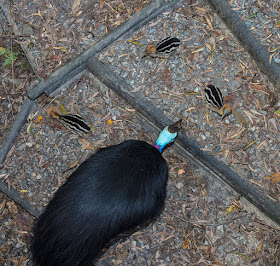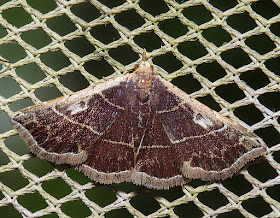Some highlights of a rather sparse spring.
See also: https://www.flickr.com/photos/naturenoises/
Remember to click on the photos to enlarge.
Amusugus tinka Trigonidiidae
Amusurgus sp responded immediately to a chip drooped on the leaf litter. Food seems to be scarce and anything will do in a pinch.
Phricta spinosa, Giant Spiny Forest Katydid, nymph. Common on rainforest understorey vegetation after dark.
Phricta spinosa, Giant Spiny Forest Katydid, nymph.
Phricta spinosa, Giant Spiny Forest Katydid, nymph.These katydids perch on large branches or tree trunks during the day. This colour patter is a good example of disruptive colouration.
Phricta spinosa, Giant Spiny Forest Katydid, nymph. Note the mites on the surface of the pronotum.
Phricta spinosa, Giant Spiny Forest Katydid, nymph. Cluster of mites on the pronotum.
A female
Balta fratercula. Males come to the lights but the females appear to be flightless so you have to go hunting for them.
This adult female
Euscyrtus hemelytrus suggests that this cricket either overwinters as an adult or late instar to mature as spring approaches.
Carbrunneria sp. This genus and
Beybienkoa are common in leaf litter as nymphs and as adults on foliage. In the last few years their numbers have diminished. Reasons?
Rhabdoblatta sp Blaberidae
Rhabdoblatta sp Blaberidae
Johnrehnia concisa male. (Click on the photo to enlarge.) In this species the white border of the pronotum is broken at the corners. In an unrelated but strikingly similar species,
Parasigmoidella atypicalis, the white border is entire all the way around.
Johnrehnia concisa, female. Check the Cockroach album on the Flickr site to see
P. atypicalis.
Tree-runner mantid,
Ciulfina sp, probably
rentzi, nymph. During the day these mantids are found only on tree trunks, rarely on termite mounds in the rainforest. But after dark they often go abroad on adjacent vegetation to feed or possibly seek new habitats.
Tree-runner mantid,
Ciulfina sp, probably
rentzi, nymph. Same as above but during the day.
A Migratory Locust,
Locusta migratoria. A vagrant and does not breed in the eastern tropics.
A last instar female Short-winged Spider Katydid
Meiophisis likkaldin, a micropterous nocturnal predatory katydid. This individual must have overwintered as a nymph. It is about ready to become an adult.
An adult male Yungaburra Spider Katydid Paraphisis alumba. This individual probably overwintered as an adult.
An adult female Chopard's Spider Katydid Paraphisis chopardi. This individual also probably overwintered as an adult.
Purple-mouthed Emerald
Emeraldagraecia munggarifrons female (Tettigoniidae; Conocephalinae; Agraeciini)
Purple-mouthed Emerald
Emeraldagraecia munggarifrons female (Tettigoniidae; Conocephalinae; Agraeciini). Purple jaws and ventral surface of fastigium black are important identifying features.
A male Balsam Beast
Anthophiloptera dryas, first of the season. Pollen and nectar-feeding katydids commonly attain adulthood during the winter when many trees and shrubs are in flower. This species seems to spend most of its time in the treetops.
The prognathous mouthparts of the Balsam Beast are well suited to dipping into flowers to feed.
An old Caedicia male shows up at the light.
Sipyloidea sp, a genus with at least 4 species in the rainforests around Kuranda.
Rarely do mayflies (Ephemeroptera) strike a useful pose.
Agape chloropyga Aganaidae
A lovely moth Abraxas expectata (Geometridae)
?Heterotropa fastosa (Arctiidae)
A common visitor Asura polyphila (Arctiidae)
Oenistis altica (Arctiidae)
A crambid
Enispa sp probably
prolectus (Noctuidae: Acontiinae). See
http://bunyipco.blogspot.com/search?q=Enispa in this blogspot.
Enispa sp probably
prolectus (Noctuidae: Acontiinae). Note larval skin near cocoon.
Cyclophragma cyclomela (Lasiocampidae)
Donuca ?castalia (Noctuidae)
Pantydia sparsa Noctuidae
Hulodes caranea Nocztuidae
Maliattha signifera Noctuidae
Corgatha sp. probably ANIC sp #3 (Noctuidae)
Eublemma sp Noctuidae
Dura niveus (Lymantriidae)
Euchaetis rhizobola (Oecophoridae)
Zatrichodes sp Oecophoridae
Garrha sp Oecophoridae
Termessa sp. (Arctiidae)
Heterallactis stenochrysa . (Arctiidae)
Moerarchis australasiella (Tineidae)
Pygospila tyres Crambidae
Uresiphita insulicola (Crambidae)
Megarostricha sphenotis Crambidae
A xyloryctid, perhaps.
A xyloryctid or oecophorid
A nice pentatomid
rainforest pentatomid
Cystopsaltria immaculata Bladder Cicada
Cystopsaltria immaculata Bladder Cicada
Longicorne Clorophorus curtisi a recent visitor to the light sheet.
Rhitiphora sp. Cerambycidae
Archetypus frenchii Ceerambycidae 'tis the season!
Chauliognathus sp.
Homocerus fossulatus Brentidae
An interested observer




































































